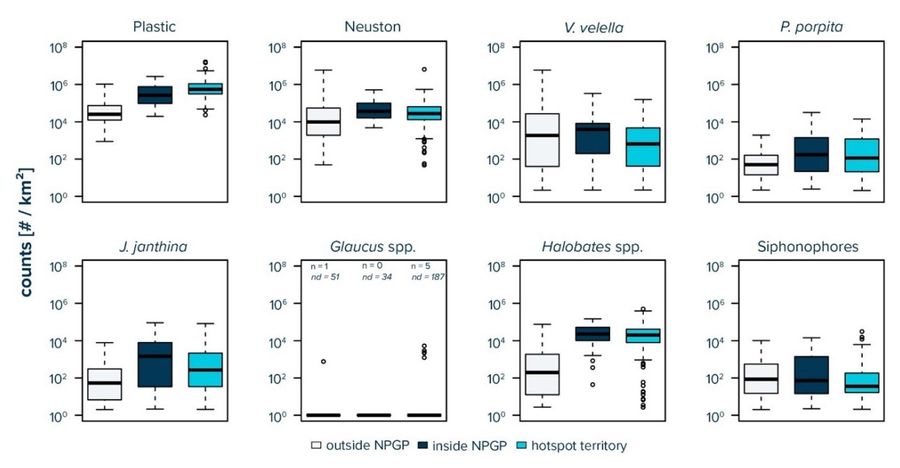
New research reveals no elevated densities of neuston within plastic hotspots inside the Great Pacific Garbage Patch
Back to updatesLatest peer-reviewed publication reveals no elevated densities of neuston in areas targeted by The Ocean Cleanup’s cleanup operations
The Great Pacific Garbage Patch is the largest accumulation of ocean plastic in the world and a known hotspot for plastic pollution impacts. It is not only home to an estimated 100,000 tons of plastic debris, but also to floating life known as neuston, a collective of species living at the sea surface that ranges from jellyfish-like drifters to sea snails. Concerns have been raised that cleanup efforts could have an adverse effect on neuston due to the potential co-accumulation of neuston and plastic at the ocean surface.
Protecting marine life is at the core of our mission. We continuously evaluate any potential impact of our operations on the environment to ensure an environmentally sound cleanup. As part of this approach, we conduct fundamental research on the ecosystem of the Great Pacific Garbage Patch. Understanding the ecosystem we operate in is crucial to maximize our environmental benefits.
To minimize potential impacts on neuston, we need to understand the distribution of plastic and neuston inside the garbage patch and how it changes across the seasons. A few years ago, we published our first study on neuston in the Great Pacific Garbage Patch. The study found that the relationship between plastic and neuston is often nonlinear and that it varies per species. Since then, our scientists have collected hundreds of additional samples from the region. The outcome of this extensive research was recently published in the peer-reviewed journal Environmental Research: Ecology.
In the Great Pacific Garbage Patch, plastic is not uniformly distributed but instead forms so-called plastic hotspots – areas with particularly high levels of plastic pollution. The new study revealed that surface waters in this hotspot territory often show similar or lower abundances of neuston compared to the wider garbage patch. In other words, while the hotspot territory contains more plastic, it does not contain more neuston. Targeting cleanups on this hotspot territory therefore not only increases the efficiency of cleanup, but it also minimizes interactions with neuston. Importantly, the hotspot territory only encompasses around ~50 % of the total surface area of the garbage patch. Thus, potential negative impacts on neuston, if occurring, will be restricted to about half of the surface area, suggesting a possible recolonization potential and limited population-level impacts.
Our scientists further found that the relative distribution of neuston and plastic varies per species and season. They observed a lower seasonality in plastic compared to neuston abundance. This suggests that species ecology is likely the key driver behind the observed seasonal patterns. At present, it remains unclear whether lower neuston densities observed within the hotspot territory are due to difference in accumulation processes of plastic vs neuston or due to negative impacts of higher plastic concentrations on neuston.
Besides operational mitigation strategies based on effective targeting of plastic hotspot areas and considering seasonal distribution patterns, cleanup technologies can further be designed such that interactions with neuston are minimized, for example, by incorporating large mesh sizes that allow neuston to pass through the system. However, larger mesh sizes also reduce the plastic capture efficiency, as fewer smaller plastic fragments are collected. Thus, the possible benefits of such measures for neuston need to be evaluated against the negative ecological impacts of microplastics.
This new research provides important new insights into neuston dynamics in the Great Pacific Garbage Patch, and its findings are reassuring. It further highlights how cleanup operations represent a unique opportunity to collect data from this remote and difficult to access region. Such data helps formulate strategies and better inform policy makers, including in the context of the UN Treaty on biodiversity beyond national jurisdiction (BBNJ) as well as the UN global plastics treaty, thus ensuring a sustainable future for the high seas.
Knowing that there is still much to discover, our scientists will continue to actively contribute to an improved understanding of the ecosystem of the Great Pacific Garbage Patch and how we maximize the ecological benefits of our offshore cleanup activities. We encourage anyone with concerns, recommendations, or any questions about our environmental research and mitigation measures to contact our Environmental and Social Affairs team at esa@theoceancleanup.com.





